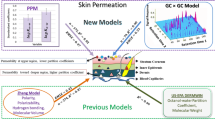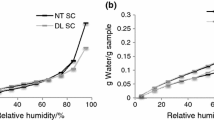Abstract
As a means of determining the risk of absorption of water contaminative phenolic compounds through the skin, the permeation of a number of phenols, all on the U.S. Environmental Protection Agency's list of priority pollutants, through hairless mouse skin has been studied, usingin vitro diffusion cell methods. Experimentally determined permeability coefficients through intact skin and stratum corneum denuded skin and permeability coefficients derived therefrom for the viable tissue layer and the stratum corneum, which are the tissue's major contributing substrata, have been correlated with their log Koctanol/water partition coefficients. Permeability coefficients for the whole skin and the stratum corneum systematically increased with increasing phenol lipophilicity to limiting values of about 0.15 and 0.30 cm/hr, respectively. The values of the permeability coefficients for the viable tissue were roughly the same for all compounds (≈0.36 cm/hr). Because of the inductive effects of Cl and NO2 substituents on the aromatic ring, phenolic analogs containing these moieties are acidic and, consequently, their overall skin permeabilities were highly pH-dependent in the range of pH values seen for surface waters. High fluxes were noted for such phenols at low pH, where they exist essentially in a non-ionized state. Though low, fluxes of the compounds were measurable at pH's ≫ pKa's, indicating that phenolic anions also pass through the skin. With the exceptions of relatively polar phenol and the mono-nitro phenols, the free acid forms of all the phenols studied permeated skin with ease and at rates approaching those of denuded skin. The intact skin permeability coefficient of the free acid form of 4-nitro phenol was exceptionally low, which suggests that it might associate intermolecularly.
Similar content being viewed by others
References
Bariin GB, Perrin DB (1966) Prediction of the strengths of organic acids. Quart Rev 20:75–100
Behl CR, Flynn GL, Linn EE, Smith WM (1984) Percutaneous absorption of corticosteroids: Age, site, and skin-sectioning influences on rates of permeation of hairless mouse skin by hydrocortisone. J Pharm Sci 73:1287–1290
Behl CR, Linn EE, Flynn GL, Pierson CL, Higuchi WI, Ho NFH (1983) Permeation of skin and eschar by antiseptics I: Baseline studies with phenol. J Pharm Sci 73:391–397
Durrheim H, Flynn GL, Higuchi WI, Behl CR (1980) Permeation of hairless mouse skin I: Experimental methods and comparison with human epidermal permeation by alkanols. J Pharm Sci 69:781–785
Flynn GL, Durrheim H, Higuchi WI (1981) Permeation of hairless mouse skin II: Membrane sectioning techniques and influence on alkanol permeabilities. J Pharm Sci 70:52–56
Hansch C, Leo AJ (1979) Substituent constants for correlation analysis in chemistry and biology, John Wiley & Sons, New York, 339 pp
Morrison RT, Boyd RN (1959) Organic chemistry. Allyn and Bacon, Boston, pp 585–588
Roberts MS, Anderson RA, Swarbrick J (1977) Permeation of human epidermis to phenolic compounds. J Pharm Pharmacol 29:677–683
Roberts MS, Anderson RA, Swarbrick J, Moore DE (1978) The percutaneous absorption of phenolic compounds: The mechanism of diffusion across the stratum corneum. J Pharm Pharmacol 30:486–490
Author information
Authors and Affiliations
Rights and permissions
About this article
Cite this article
Huq, A.S., Ho, N.F.H., Husari, N. et al. Permeation of water contaminative phenols through hairless mouse skin. Arch. Environ. Contam. Toxicol. 15, 557–566 (1986). https://doi.org/10.1007/BF01056570
Received:
Revised:
Issue Date:
DOI: https://doi.org/10.1007/BF01056570




